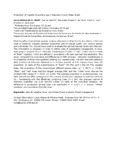Please use this identifier to cite or link to this item:
http://www.alice.cnptia.embrapa.br/alice/handle/doc/511243| Title: | Production of copaíba (Copaifera spp.) oleoresin in Acre State, Brazil. |
| Authors: | WADT, L. H. de O.  MARTINS, K.   SILVA, M. das G. C. da   RUIZ, R. C.   ARAÚJO, E. A. de   |
| Affiliation: | LUCIA HELENA DE OLIVEIRA WADT, CPAF-AC KARINA MARTINS, Universidade Federal de São Carlos MARIA DAS GRAÇAS C. DA SILVA, CTA ROCÍO C. RUIZ, Seaprof EVANDRO A. DE ARAÚJO, CTA. |
| Date Issued: | 2008 |
| Citation: | In: WORKING FORESTS IN THE TROPICS: PARTNERING RESEARCH WITH PRATICE FOR CONSERVATION AND DEVELOPMENT, 2008, Gainesville. Abstract book and program. Gainesville: University of Florida, 2008. |
| Pages: | 1 p. |
| Description: | Most Copaifera tropical tree species produce oleoresins in their trunks and stems, which are used as medicine. Copaiba oleoresin production and its overall quality vary among species and individuals. Few studies have tried to evaluate the optimal harvest levels and intervals. This information is necessary in order to define rules of sustainable management. In Acre, local people recognize five C. reticulata morphotypes (?yellow?, ?red?, ?white? and two kinds of ?black? copaiba), which are defined in accordance with bark and leaf characteristics. This study compared the occurrence and differences in DBH among C. reticulata morphotypes in 41 properties of three municipalities, totaling 621 copaiba trees. |
| Thesagro: | Óleo Essencial |
| NAL Thesaurus: | Amazonia |
| Keywords: | Óleo de copaíba Brasil |
| Type of Material: | Resumo em anais e proceedings |
| Access: | openAccess |
| Appears in Collections: | Resumo em anais de congresso (CPAF-AC)  |










